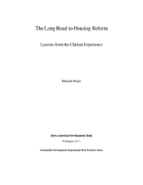The Long Road to Housing Reform: Lessons from the Chilean Experience
Date
Jul 1999
Chile's housing policy is widely regarded as a success. For almost a decade, new construction has been above the level required to provide houses for new families and replace obsolete structures. This raises hopes that within the next decade all families in Chile will occupy dwellings that comply with minimum quality and service standards. This is no small accomplishment for a country just entering the middle ground in the development scale. Moreover, the private sector is taking an increasingly active role in housing production and financing. This too is a significant achievement considering that in the 1970s most housing was built and financed by the government. Further, government assistance is effectively reaching the poor, and most public resources are benefiting low-income households. Confidence in the housing policy is high among the low-income population as expressed in their high level of participation in a housing savings program and by the absence of land invasions. These accomplishments are the result of a long maturation process in the Chilean housing sector. Fifty years of government policy have consolidated the legal, institutional, and entrepreneurial foundations of the current housing production and financing system. Several success factors can be identified: an integrated sector approach (which incorporates the housing needs of all income groups); an efficient subsidy system (the result of a long process of experimentation); and reforms of the general banking system and the social security system (which created strong institutions to intermediate the financial resources accumulated by pension funds and life insurance companies). Even with its accomplishments, Chile's housing sector still faces significant challenges. Improvements are needed to more effectively mobilize the resources devoted to housing. The lack of coordination between housing and urban development policies is becoming a major liability for both efficient housing production and equitable urban growth. Direct government involvement in house construction and home financing enforce uniformity in design and repayment schedules failing to fully meet the diversified demand of the target households and to fully mobilize the repayment capacity of beneficiaries. It is suggested that it may be time for housing policy to move beyond this basic approach introducing more flexibility through greater market participation in low-income housing.



